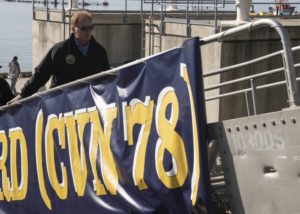Acting Secretary of the Navy Thomas Modly disclosed more details about the Navy’s new integrated Force Structure Assessment (FSA) Friday including that it moves toward a fleet size closer to 390 ships.
The new FSA reaches a fleet size of about 435 ships when including unmanned vessels and about 390 without including them, Modly said during an event Feb. 28 at the Brookings Institution.

However, he believes it is irrelevant whether future unmanned vessels should count as part of the top ship count but notes they will be part of the future force mix.
“Whether we count it as part of how we would traditionally count 355 or not, I kind of think it’s irrelevant. I’ve been calling it 355-plus since I was sworn in as Under Secretary,” Modly said.
“So, to me, I just think that just gets into a debate about a number that’s not really that relevant. So we are talking about capabilities. Unmanned systems will be a critical part of our future maritime capability, for sure. We’re investing in that. It’s in our budget,” Modly continued.
Modly noted beyond reiterating a goal of 12 aircraft carriers the new FSA will have “inflection points” differing from the previous 2016 FSA aside from total fleet size.
“One of the more significant things is deemphasis on large surface combatants. We’ll see that number come down in favor of more, small, highly capable small surface combatants like the frigate [and] some of the things we’re thinking of doing with the LCS.”
The 2016 FSA concluded the Navy needed 355 ships consisting of 12 aircraft carriers, 104 large surface combatants, 52 small surface combatants, 38 amphibious warfare ships, 66 attack submarines, 12 ballistic missile submarines, 32 combat logistics force ships, 10 expeditionary fast transport vessels, six expeditionary support bases, and 23 command and support ships (Defense Daily, Dec. 16, 2016).
Modly noted the end state numbers of unmanned vessels in the FSA “are still in flux and I’m totally comfortable with that being in flux.”
“So whether we end up with 45 of something we don’t know or 50 or 75 of something we don’t know is sort of irrelevant. We know we have to start moving down the path toward unmanned and understand how that’s going to work,” Modly continued.
Modly said the FSA will also look at two new classes of ships: a smaller more lightly manned amphibious vessel to support distributed maritime operations and the Marine Commandant’s plan of expeditionary advanced base operations as well as a combat support ship to support such vessels.
“We currently don’t have either one of those types of ships in the fleet right now, nor on the drawing board,” so the service is requesting research and developing funding in the fiscal year 2021 budget request.
The Navy’s submission requested $30 million to start research and development work on each vessel, costing $60 million total. Budget documents describe them as a “next generation medium amphibious ship” to support amphibious ship-to-shore operations and a medium logistics ship “to support theater lift requirements” (Defense Daily, Feb. 20).
Relatedly, Modly also revealed another hiccup in releasing the FSA beyond Defense Secretary Mark Esper wanting to integrate it with the 30-year shipbuilding plan: a Director of Cost Assessment and Program Evaluation (CAPE) report.
“CAPE did its own analysis – there are some departures between our analysis and CAPE’s analysis that the Secretary of Defense wants to look at more closely. I don’t think they’re that significant when you’re talking about a plan…over 10 yrs. But the secretary, you know, it’s his prerogative so we’re supporting him in taking a look at that.”
“Hopefully, over the next couple of months, we’ll probably tighten up some of those differences,” Modly added.